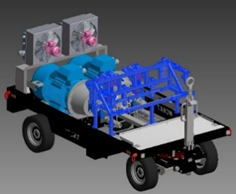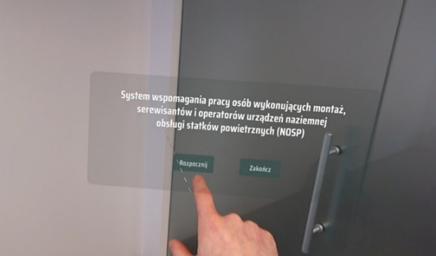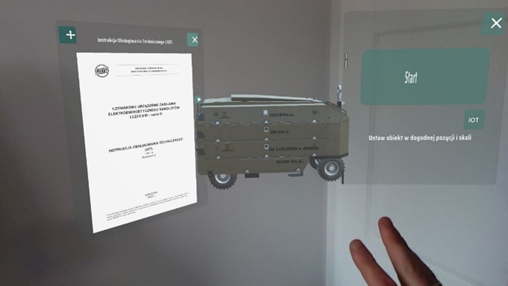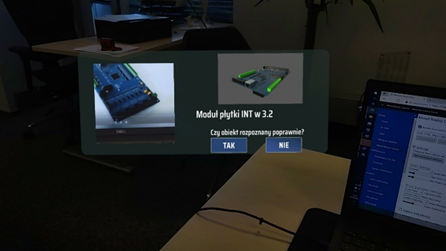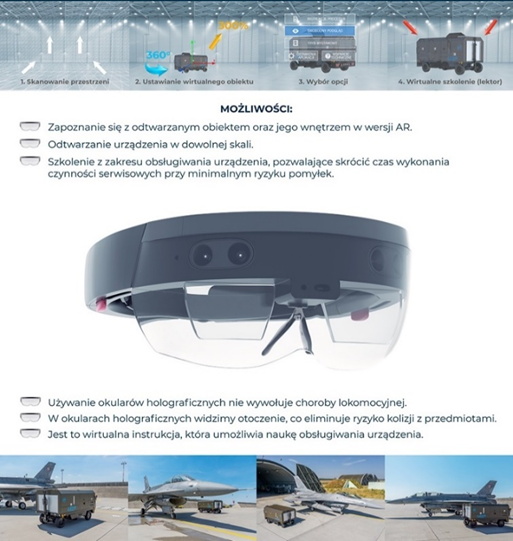System supporting the work of assembly workers, service technicians and operators of aircraft ground support equipment based on augmented reality technology

 Project title
Project title
System supporting the work of assembly workers, service technicians and operators of aircraft ground support equipment based on augmented reality technology
 Name of Beneficiary/Beneficiaries
Name of Beneficiary/Beneficiaries
Wojskowe Centralne Biuro Konstrukcyjno-Technologiczne S.A. & SIM Factor Sp. z o.o.
 Name of programme
Name of programme
Operational Program “Smart Growth”
 Competition
Competition
Fast Track for the Mazovia Region
 Project value
Project value
PLN 7,014,835.00
 Funding value
Funding value
PLN 3,806,369.26
 Project delivery period
Project delivery period
01.06.2021 – 30.11.2023
Results of our work
Issues addressed
The Military Central Office for Construction and Technologies Office (Wojskowe Centralne Biuro Konstrukcyjno-Technologiczne S.A.) deals with designing and building modern equipment for defense purposes, holding the position of a leading supplier in the field of military aircraft ground support equipment used to:
- energize on-board systems,
- fill on-board systems with compressed oxygen, nitrogen and air,
- check the technical condition of aircraft hydraulics and replenish and filter working liquids.
Additionally, the Office provides maintenance services to all clients to whom it has supplied devices built by it. The assembly, service and maintenance work performed on these devices requires high precision and great emphasis is placed on training in this area.
The project aims to solve problems related to the precision and efficiency of work of assembly workers, service technicians and operators of aircraft ground support equipment.
The project uses augmented reality technology, which allows virtual replicas of actual devices (seen through glasses) to be embedded in the real world. Replicas can be scaled depending on needs (the virtual vehicle can be as big as the real one, but it can also be larger or smaller). Then, for each virtual vehicle, you can run a selected virtual operating or assembly procedure that shows step by step what should be done to do the requested work.
Thanks to the use of augmented reality technology, users can see precise tips, instructions and information on specific actions to be performed. This allows the trainee to work faster, more effectively and without errors, which contributes to increasing safety and quality of aircraft service. Additionally, this system allows for ongoing monitoring of work results and detecting mistakes, which further improves the process of carrying out specific activities.
Finally, it is worth pointing out that the project provided a training method suitable for various applications, eliminating the need to use real equipment.
Project beneficiaries
As a result of the project, an AR solution was created in the form of an application uploaded to goggles. The solution supports the Office’s teams in performing the following processes:
- Assembly / installation: The solution allows the worker to determine whether the correct component was used and installed in the right place. The benefits are increased precision of work and avoidance of human errors that may result in damaging or downgrading reliability of aircraft ground support equipment. Additionally, it allows employees to be shown exactly what the specialist needs at a given moment while working. Therefore, it shortens the time needed to install equipment and enables simultaneous work on the assembly line with various types of ground support equipment.
- Maintenance: The solution can display procedures defined in current and periodic maintenance manuals, and clearly reproduce the most complicated service procedures. The solution can be used both by the Office’s employees and employees of other companies handling aircraft ground support equipment directly on site.
- Technical support: The solution allows for remote virtual assistance by enabling on-site technicians to contact the Office’s experts who can offer immediate diagnosis and repair tips for cases requiring specialized knowledge. Support can be provided immediately, in real time, both during and after business hours of the Office.
- Training: The solution has been included in the training cycle. It enables innovative ways of training and preparing aircraft ground support equipment assemblers, service technicians and operators, also directly before starting work on the airfield apron.
Major implementation challenges
The biggest challenge in the project was learning to recognize objects. Objects visible through the camera may be partially obscured by some components of the device. The edges may be shaded. This happens quite often when the device is used to support the assembly or maintenance of aircraft ground support equipment (for example, an element is partially covered by electrical wires, a shadow is cast on the edges, or the element shines in the light). Such equipment has hundreds or thousands of different parts and, additionally, there are a number of installation schemes, so different components may fit into a given place. You need to find out which one is correct. Additional difficulties are technical changes, newer versions of parts and substitutes. All this makes it much more difficult to recognize and identify the right component.
Our advice to other applicants
- Plan your activities and project goals carefully – the better prepared the application, the better the odds for obtaining funding.
- Cooperate with partners – benefit from the experience of other institutions and organizations that can support the implementation of the project.
- Try to be innovative – EU funds are often awarded for projects that introduce new solutions or technologies.
- Take care to diversify financing sources – the greater the diversity, the lower the risk for the project.
- Regularly monitor work progress and adjust activities if necessary – flexibility and ability to adapt to changes are essential when implementing an EU project.
- Follow rules and regulations carefully – staying honest and compliant will help you avoid problems during project evaluation.
- Be open to feedback and suggestions – it is worth using opinions of experts and outsiders who can provide valuable comments on the course of the project.
- Remember to properly promote the project – tell people about your achievements and results to increase the visibility of the project and its positive impact on the community.
